English | Dutch |
|
| Ashgabat: marble city | |
Mary (Turkmenistan), March 18th 2013
|
|
| |
|
A nice aspect about travelling is that you sometimes visit destinations you were almost unaware of. Most of the times, these destinations are surprising because of the fact that your expectations were almost completely blank. Ashgabat, the capital city of Turkmenistan, is such a destination. Turkmenistan is a country in Central Asia and only became a country in 1991, when the Soviet Union collapsed. It is one of the most isolated countries in the world. The country is ruled by dictators since its existence in 1991, first by Saparmurat Niyazov, and since his death in 2006 by the man with the almost impossible name Gurbanguly Berdymukhamedov (three times word value in Scrabble!). Turkmenistan is a totalitarian police state. Turkmenistan isn’t often in the news in the western world. And that is surprising because of it dictatorial regime. But in some way, Turkmenistan always managed to keep the west and other world powers satisfied. That means that there was never real pressure from other countries that pushed for political reform. Turkmenistan has a lot of oil and natural gas, and it proved to be very effective to keep radical Islam out of the country, and that is special in this volatile region. These two ingredients are the two main reasons why the west, Russia and China tolerated the regime, so far. So, for the time being, the Turkmen dictatorship has nothing to be afraid of. No real changes are expected soon. |
|
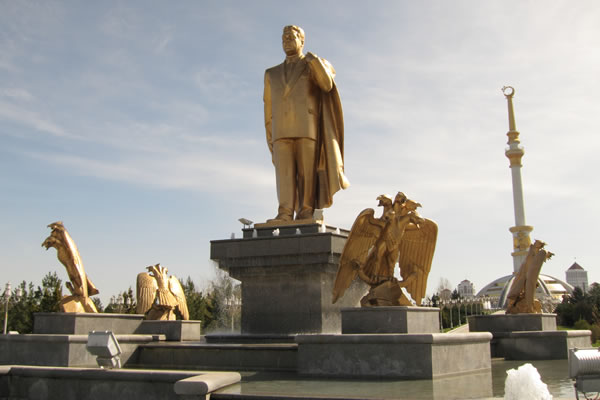 |
|
Statue of former president Niyazov in Independence Park |
|
The visit to Turkmenistan was surprising for us. We never visited a country before where the regime is so xenophobic and where it is so visible that the country is ruled by a dictator. The regime is frantic when it comes to foreigners. A tourist visa is only issued if you agree to be accompanied by a guide during the full length of your visit to the country. The other option is the transit visa, which gives you three to five days to transit Turkmenistan to one of the bordering countries. The time you can spend in the country is limited, but a guide is not necessary and that means more freedom. We were lucky to get a 5-day transit visa on our way from Iran to Uzbekistan. Enough to get a glimpse into this isolated country. During our 5-day stay in Turkmenistan, of which we spend three in the capital city Ashgabat, we got to know the Turkmen people as very friendly. We had the feeling that people are a little bit distant, but that is normal in a country where the regime has eyes and ears everywhere. Contact with foreigners can only lead to problems is what the local people probably think. Free press is non-existent in Turkmenistan. The country is almost at the bottom of the free press index list of the organisation Reporters without Borders. On TV, you mainly see programs in where national identity is central and in where the president (dictator) is adored. Potentially, the country is very rich. It has vast oil and gas reserves, which means that the country could be the Kuwait of Central Asia. But unfortunately, the money is mainly spent on huge and foolish public projects. Besides that, the personality cult involving the president is also a popular way to spend huge amounts of money. His picture is really everywhere. Ashgabat is like a marble city. Many parts of town are full of white marble palaces, ministries, universities, institutes, statues and even apartment blocks. And that is not all. Also the railway station, the market buildings, the fountains, the mosque and even the underground pedestrian passageways are built with marble. And the newest project is a gigantic Olympic Complex, consisting of several stadiums, all of which are most likely made with marble. The world’s marble business is undoubtedly hoping that this regime will stay in power for a long time to come. | |
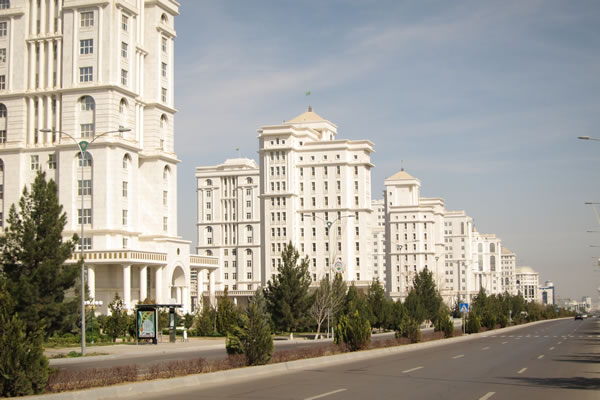 |
|
Marble appartment blocks on Turkmenbashi Sayoli |
|
| Police and military presence is very visible in the city. You will see several police agents on most crossings in Ashgabat, and all important public buildings are guarded by soldiers. Some streets and sidewalks in front of public buildings are no-go zones for normal people, which mean that you have to cross the street and continue your walk on the other side. Making photographs in Ashgabat is a risky business. Public buildings are taboo. We asked several times at a nearby policemen or soldier if it was allowed to photograph a palace, but the answer was always short and strong: no! We almost had some trouble when we tried to photograph a vegetable market. The only things that are normally accepted are the typical tourist attractions, often in parks (like fountains and statues).
The Turkmen people are very unlucky that their dictators so far, really like themselves. The previous president, which was also the first one of the country, was worse that the present one. His name was Niyazov, and he even forced the people to call him Turkmenbashi, which translated into ‘leader of the Turkmen people’. He even named a city after himself. He is also the one who erected golden statues of himself everywhere in the country and his picture was on all major buildings. He was also the architect of some strange rules, like the ban on listening music in cars. The present president is said to be less visible. However, we can not really say that he isn’t there in public life. Also his picture is everywhere and he is most of the time portrayed in the same way, but with different backgrounds. He undoubtedly thinks that he has a ‘best look’ and that is the only way he is allowed to be portrayed. Despite the fact that our visit to Turkmenistan was short, we still got a first impression of it. The experience that the country is a totalitarian theme park is probably the impression we will remember most, but that is partly unfair. Turkmenistan is a beautiful country, with century old traditions and very friendly people. All we can hope is that there will be some political reforms soon, not only for the Turkmen people, but also for us as travellers, because a change in regime will probably mean that future travellers will be allowed to get a better impression of this undoubtedly fabulous country. | |
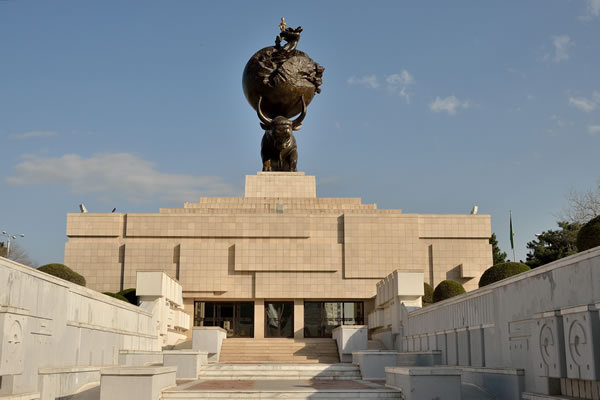 |
|
The Earthquake Museum and Monument on Independence Square |
|
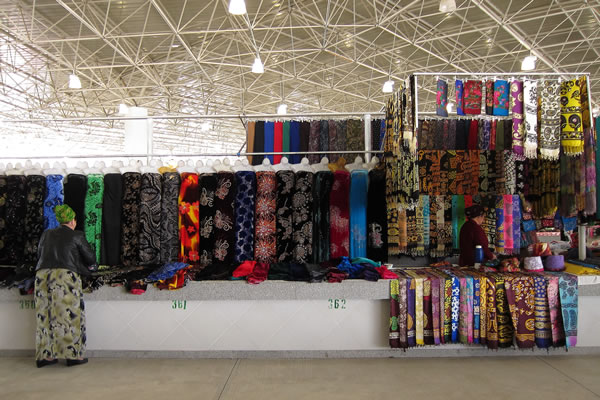 |
|
Textile in large quantities for sale in Tolkucha bazaar |
|
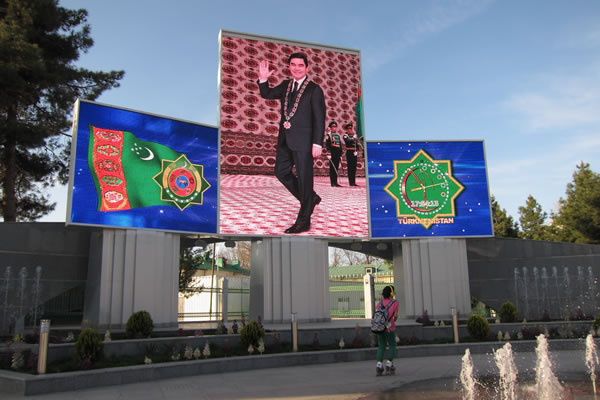 |
|
Berdymukhamedov's image is literally everywhere, like in this small park |
|
 |
|
Ashgabat's answer on Istanbul's Blue Mosque: the Azadi Mosque |
|
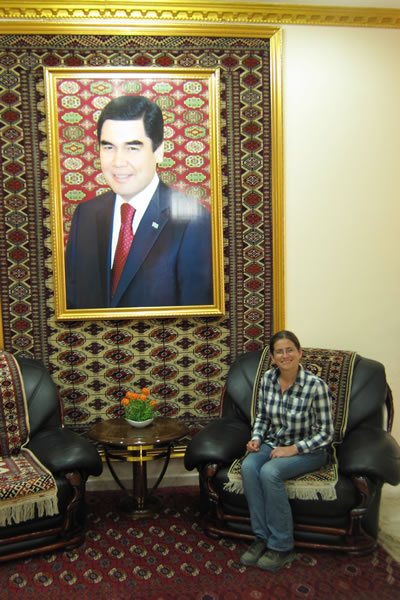 |
|
Berdymukhamedov's portrait is also available in our hotel's lobby |
|